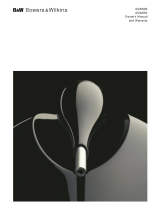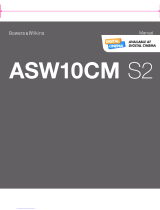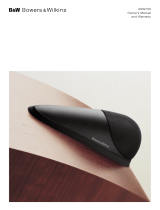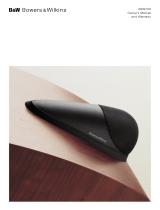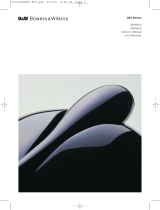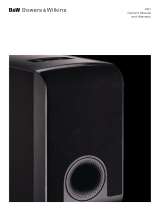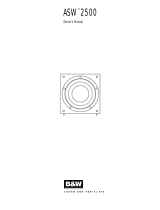Page is loading ...

Kevlar is a registered trademark of DuPont.
Nautilus is a trademark of B&W Group Ltd.
Copyright © B&W Group Ltd. E&OE
Printed in China.
B&W Group (UK Sales)
T +44 1903 221 500
B&W Group North America
T +1 978 664 2870
B&W Group Asia Ltd
T +852 3 472 9300
B&W Group Ltd
Dale Road
Worthing West Sussex
BN11 2BH England
T +44 (0) 1903 221800
F +44 (0) 1903 221801
info@bwgroup.com
www.bowers-wilkins.com
II11951 Issue 3
CM Series
ASW 10CM
ASW 12CM
Owner’s Manual
Figure 1
Subwoofer
Figure 3
Subwoofer
Processor
LR
Speaker Outputs
Rear
LR
Front
Figure 4
Processor
LR
Speaker Outputs
Rear
LR
Front
Subwoofer
Subwoofer
Integrated Amplifier
Speaker OutputsLine Out
Figure 5
Subwoofer
Figure 6
Integrated Amplifier
Speaker Outputs
LR
SPEAKERSSPEAKERS
LR
L
Figure 2
SPEAKERS
Processor
Rear Amplifier
R
Input
LR
Speaker Outputs
Centre Channel Amplifier
L
R
Input
LR
Speaker Outputs
L
R
Input
LR
Speaker Outputs
Front Amplifier
Line Outputs
RearCentreFront
Subwoofer
SPEAKERS
SPEAKER
Subwoofer
1
2
3
4
5
6
7
8
9
10
11
12
13
14
L
R
ASW10-12 OM issue3.indd 1-3 3/4/09 08:51:09

Kevlar is a registered trademark of DuPont.
Nautilus is a trademark of B&W Group Ltd.
Copyright © B&W Group Ltd. E&OE
Printed in China.
B&W Group (UK Sales)
T +44 1903 221 500
B&W Group North America
T +1 978 664 2870
B&W Group Asia Ltd
T +852 3 472 9300
B&W Group Ltd
Dale Road
Worthing West Sussex
BN11 2BH England
T +44 (0) 1903 221800
F +44 (0) 1903 221801
info@bwgroup.com
www.bowers-wilkins.com
II11951 Issue 3
CM Series
ASW 10CM
ASW 12CM
Owner’s Manual
Figure 1
Subwoofer
Figure 3
Subwoofer
Processor
LR
Speaker Outputs
Rear
LR
Front
Figure 4
Processor
LR
Speaker Outputs
Rear
LR
Front
Subwoofer
Subwoofer
Integrated Amplifier
Speaker OutputsLine Out
Figure 5
Subwoofer
Figure 6
Integrated Amplifier
Speaker Outputs
LR
SPEAKERSSPEAKERS
LR
L
Figure 2
SPEAKERS
Processor
Rear Amplifier
R
Input
LR
Speaker Outputs
Centre Channel Amplifier
L
R
Input
LR
Speaker Outputs
L
R
Input
LR
Speaker Outputs
Front Amplifier
Line Outputs
RearCentreFront
Subwoofer
SPEAKERS
SPEAKER
Subwoofer
1
2
3
4
5
6
7
8
9
10
11
12
13
14
L
R
ASW10-12 OM issue3.indd 1-3 3/4/09 08:51:09

Owner details
Title, first name, surname
Address
Town, postcode, country
e-mail address
Product details
Model
Serial number
Date of purchase
Dealer details
Dealer name
Address
Town, postcode, country
e-mail address
Dealer stamp
TRIM FOLD FOLD
Figure 1
Subwoofer
Figure 3
Subwoofer
Processor
LR
Speaker Outputs
Rear
LR
Front
Figure 4
Processor
LR
Speaker Outputs
Rear
LR
Front
Subwoofer
Subwoofer
Integrated Amplifier
Speaker OutputsLine Out
Figure 5
Subwoofer
Figure 6
Integrated Amplifier
Speaker Outputs
LR
SPEAKERSSPEAKERS
LR
L
Figure 2
SPEAKERS
Processor
Rear Amplifier
R
Input
LR
Speaker Outputs
Centre Channel Amplifier
L
R
Input
LR
Speaker Outputs
L
R
Input
LR
Speaker Outputs
Front Amplifier
Line Outputs
RearCentreFront
Subwoofer
SPEAKERS
SPEAKER
Subwoofer
1
2
3
4
5
6
7
8
9
10
11
12
13
14
L
R
ASW10-12 OM issue3.indd 4-6 3/4/09 08:51:12

1
Power Amplifie
Line In
S
L
R
Figure 12
Pre-Amplifier
Power Amplifier
Speaker OutputsLine In
SPEAKERS
LR
L
R
Figure 9
Line Out
L
R
Pre-Amplifier
Subwoofer
Right Subwoofer
Integrated Amplifier
S
peaker OutputsLine Level Outputs
Figure 7
S
PEAKERS
LR
L
R
Left Subwoofer
P
ower Amplifie
L
ine In
L
R
Figure 10
P
re-Amplifier
Figure 8
Integrated Amplifier
Outputs
LR
SPEAKERS
Right Subwoofer Left Subwoofer
Power Amplifie
Line In
S
L
R
Figure 11
Pre-Amplifier
7276 10 CM manual revised.qxd 27/3/09 10:11 Page 1

2
Left Subwoofer
Right Subwoofer
Power Amplifier
Speaker OutputsLine In
SPEAKERS
LR
L
R
Figure 12
Line Out
L
R
Pre-Amplifier
Left Subwoofer
Right Subwoofer
Power Amplifier
S
peaker OutputsLine In
S
PEAKERS
LR
L
R
Figure 10
L
ine Out
L
R
Pre-Amplifier
Subwoofer
Power Amplifier
Speaker OutputsLine In
SPEAKERS
LR
L
R
Figure 11
Line Out
L
R
P
re-Amplifier
7276 10 CM manual revised.qxd 27/3/09 10:11 Page 2

3
Contents
English
Owner’s Manual............4
Limited Warranty...........8
Français
Manuel d’utilisation.......9
Garantie limitée...........15
Deutsch
Bedienungsanleitung...16
Garantie .....................22
Español
Manual de
instrucciones ..............23
Garantía limitada.........29
Português
Manual do utilizador....30
Garantia limitada.........35
Italiano
Manuale di istruzioni ...36
Garanzia limitata .........41
Nederlands
Handleiding ................42
Garantie .....................47
Ελληνικά
Ãδηγίες Ìρήσεως ....48
Περιïρισµένη
εγγύηση....................55
Русский
Руководство по
эксплуатации ............56
Ограниченная
гарантия....................62
"esky
Návod k pouãití..........64
Záruka .......................69
Magyar
Használati útmutató ...70
Korlátozott garancia ..75
Polski
Instrukcja
uÃytkownika ...............76
Gwarancja .................81
.....................82
.......................87
.......................88
.......................91
.......................92
.......................95
EU Declaration of
Conformity..................98
T
echnical
Specifications......99–100
7276 10 CM manual revised.qxd 27/3/09 10:11 Page 3

4
English
Owner’s manual
Important Safety Instructions
1. Read these instructions.
2. Keep these instructions.
3. Heed all warnings.
4. Follow all instructions.
5. Do not use this apparatus near water.
6. Clean only with dry cloth.
7. Do not block any ventilation openings. Install in
accordance with the manufacturer’s instructions.
8. Do not install near any heat sources such as
radiators, heat registers, stoves, or other
apparatus (including amplifiers) that produce heat.
9. Do not defeat the safety purpose of the polarized
or grounding-type plug. A polarized plug has two
blades with one wider than the other. A grounding
type plug has two blades and a third grounding
prong. The wide blade or the third prong are
provided for your safety. If the provided plug does
not fit into your outlet, consult an electrician for
replacement of the obsolete outlet.
10. Protect the power cord from being walked on or
pinched particularly at plugs, convenience
receptacles, and the point where they exit from
the apparatus.
11. Only use attachments/accessories specified by the
manufacturer.
12. Use only with the cart, stand, tripod,
bracket, or table specified by the
manufacturer, or sold with the
apparatus. When a cart is used, use
caution when moving the
cart/apparatus combination to avoid injury from
tip-over.
13. Unplug this apparatus during lightning storms or
when unused for long periods of time.
14. Refer all servicing to qualified service personnel.
Servicing is required when the apparatus has been
damaged in any way, such as power-supply cord
or plug is damaged, liquid has been spilled or
objects have fallen into the apparatus, the
apparatus has been exposed to rain or moisture,
does not operate normally
, or has been dr
opped.
15. Do not expose this apparatus to dripping or
splashing and ensure that no objects filled with
liquids, such as vases, are placed on the
apparatus.
16. To completely disconnect this apparatus from the
AC Mains, disconnect the power supply cord plug
fr
om the AC r
eceptacle.
17. The mains plug of the power supply cord shall
remain readily operable.
1
8. When replacement parts are required, be sure the
service technician has used replacement parts
s
pecified by the manufacturer or have the same
characteristics as the original part. Unauthorised
s
ubstitutions may result in fire, electric shock or
o
ther hazards.
1
9. Check that there are no cables under the carpet
that may be damaged by the spike feet. Do not
w
alk the product on the spike feet as this may
cause them to become detached from the cabinet
and cause damage. Take care not to impale
y
ourself with the spike feet.
20. For continued protection against fire hazard, use
fuses only of the correct type and rating. Mains
f
uses are located inside the appliance as well as
on its back panel. Replacement of the internal
fuse should be entrusted to an authorised
operative. User-replaceable fuse types are shown
in the specification.
21. Isolation of the appliance from the power supply is
by means of removal of the power cord from the
rear of the appliance or removal of the power cord
from the wall power outlet. Either the wall outlet or
the rear of the appliance must remain freely
accessible at all times while the apparatus is in use.
22. This product should be operated only from the
type of power source indicated by the marking
adjacent to the power cord entry. If you are not
sure of the type of power supply to your home,
consult your product dealer or local power
company.
23. Do not overload wall outlets, extension cords or
integral convenience receptacles, as this can
result in a risk of fire or electric shock.
24. Magnetic fields – The product creates a stray
static magnetic field. Do not place any object that
may be damaged by this magnetic field (eg
cathode ray tube televisions or computer
monitors, audio and video tapes and swipe cards)
within 0.5m (2 feet) of the appliance. The
appliance may cause distortion of cathode ray
tube images beyond this distance. LCD and
Plasma screens are not affected.
25. Mounting – Do not place this product on an
unstable stand, tripod, bracket or table. The
product may fall causing serious injury and serious
damage. Any mounting of the product should
follow the manufacturer’s instructions.
The presence of this symbol on the product warns the
user that ther
e is a risk of danger
ous electrical shock if
the product is opened beyond the point at which the
symbol appears. There are no user serviceable parts
inside. Leave servicing to qualified personnel.
CAUTION
RISK OF ELECTRIC SHOCK
DO NOT OPEN
A
VIS:
RISQUE DE CHOC ELECTRIQUE – NE P
AS OUVRIR
7276 10 CM manual revised.qxd 27/3/09 10:11 Page 4

5
T
he lightning flash with arrowhead
symbol within an equilateral triangle, is
i
ntended to alert the user to the
presence of uninsulated “dangerous
v
oltage” within the product's enclosure
t
hat may be of sufficient magnitude to
constitute a risk of electric shock to
p
ersons.
T
he exclamation point within an
equilateral triangle is intended to alert
the user to the presence of important
o
perating and maintenance (servicing)
instructions in the literature
accompanying the product.
W
ARNING: To reduce the risk of fire or electric
shock, do not expose this apparatus to rain or
moisture.
Do not expose the device to rain, use it near water or
in damp or wet conditions, or place containers on it
containing liquids which might spill into any openings.
When setting up the device, make sure that the AC
outlet you are using is easily accessible. If some
trouble or malfunction occurs, immediately turn off the
power switch and disconnect the plug from the outlet.
Even when the power switch is turned off, electricity is
still flowing to the product at the minimum level. When
you are not using the device for a long time, make
sure to unplug the power cord from the wall AC outlet.
Introduction
Dear customer,
Thank you for choosing Bowers & Wilkins. Please read
this manual fully before unpacking and installing the
product. It will help you to optimise its performance.
B&W maintains a network of dedicated distributors in
over 60 countries who will be able to help you should
you have any problems your dealer cannot resolve.
Environmental Information
All B&W products are designed to comply
with international directives on the
Restriction of Hazardous Substances
(RoHS) in electrical and electronic equipment and the
disposal of Waste Electrical and Electronic Equipment
(WEEE). These symbols indicate compliance and that
the products must be appropriately recycled or
processed in accordance with these directives. Consult
your local waste disposal authority for guidance.
Carton Contents
Check in the carton for:
1 Mains cable
1 Accessory pack containing:
4 M6 spike feet
4 M6 rubber feet
4 Lock nuts (10mm acr
oss flats)
Installation
The subwoofer has been designed both for Home
Theatre installations and to augment the bass
performance of ‘full range’ speakers in 2-channel
audio systems. All audio installations require some
t
hought in installation if they are to reach their full
performance potential and this manual will guide you
t
hrough the process.
T
he subwoofer requires connection to the mains
power supply, so it is important that you familiarise
y
ourself with the safety instructions and heed all the
w
arnings. Keep this manual in a safe place for future
reference.
The Subwoofer Connection and Control
Panel
(Figure 1)
1. Status indicator.
2. On, Auto, Stand-by switch.
3. Line-level input volume.
4. Speaker level input volume.
5. Low-pass filter frequency.
6. Low-pass filter selection switch.
7. Bass extension switch.
8. Equalisation switch.
9. Phase reverse switch.
10. 12V trigger input.
11. Line level input sockets (left and right).
12. Speaker level input binding posts (left and right).
13. Mains input.
14. External fuse holder.
Subwoofer Applications
The primary function of a subwoofer is to reproduce
signals from an audio-visual processor Low Frequency
Effects (LFE) channel. In addition, the processor may
be configured to divert the low bass portion from
some or all of the other channels and add it to the LFE
information. This is usually done by selecting “small”
loudspeakers in the processor set-up procedure.
In 2-channel audio applications a subwoofer is used to
extend the bass response lower than that provided by
the satellite speakers. The subwoofer low-pass filter
should be set so that the subwoofer takes over as the
output of the satellite speakers falls.
Subwoofer Positioning and Installation
The ear poorly perceives the source location of low
frequency sound so the position of subwoofers in the
listening room is generally less critical compared to
full-range speakers. However, best results are usually
obtained if the subwoofer is placed between the left
and right speakers or in the vicinity of one of them. If
two subwoofers are used, it is best to put one near
the left and one near the right speaker
. Placing a
subwoofer behind the listening position, even in multi-
channel surround sound installations, generally results
in inferior imaging, but may be an acceptable
compr
omise if domestic considerations dictate.
As with all speakers, the proximity of room boundaries
affects the sound of a subwoofer. Bass volume
incr
eases as mor
e surfaces come into close pr
oximity
with the speaker
. Unlike full-range speakers, however,
the overall system balance can be corrected by
7276 10 CM manual revised.qxd 27/3/09 10:11 Page 5

6
a
djusting the volume level of the subwoofer. The more
boost gained from the room, the lower the volume can
b
e set and the less hard the subwoofer has to work;
but there is a down side. Subwoofers positioned near
c
orners often generate more low-frequency room
r
esonances, making the bass more uneven with
frequency. There is no substitute for experiment as all
r
ooms behave differently, so the subwoofer should be
t
ried in a variety of positions before a final decision is
made. A piece of music with a bass line ascending or
d
escending the musical scale is useful for assessing
the smoothness of the bass response. Listen for
e
xaggerated or quiet notes.
If the subwoofer is to be used in a confined space
(e.g. built into furn
iture), the space must be ventilated
t
o allow sufficient air to circulate and cool the unit. Ask
your dealer for advice.
The subwoofer is intended to be floor mounted only. It
is important to ensure the subwoofer stands firmly on
the floor using the spike feet supplied whenever
possible. The spike feet are designed to pierce carpet
and rest on the floor surface. Initially, screw the lock
nuts onto the spikes enough to leave the nuts floating
just above the carpet when the spikes are resting on
the floor beneath. Screw the spikes fully into the
threaded inserts in the base of the cabinet. If the
cabinet rocks when placed on the floor, unscrew the
two spikes that do not touch the floor until the cabinet
rests firmly without r
ocking. Finally, lock the nuts
against the cabinet. It may be more convenient to fit
and adjust the spike feet after speaker positioning has
been optimised.
If there is no carpet and you wish to avoid scratching
the floor surface, use either a protective metal disc (a
coin perhaps) between the spike and the floor or use
the supplied rubber feet. Fit the rubber feet by
screwing one into each of the holes in the underside
of the cabinet.
The grille fitted to the front of the subwoofer may be
removed if desired. Take care however not to touch
the moving parts of the drive unit as damage may
result.
Using Multiple Subwoofers
Using multiple subwoofers in a single installation can
improve performance in the following ways:
• Maintain stereo separation to the lowest
frequencies.
• Smooth out the effects of low frequency room
resonances.
• Enable a higher maximum sound output.
In the case of two subwoofers used in a
2-channel audio system, stereo separation will only be
improved if each channel has its own subwoofer
located close to the appr
opriate satellite speaker
.
Electrical Connections
Disconnect all audio system equipment from the mains
until the signal connections have been made and
checked. This avoids the risk of damage whilst
connections are made or broken. The subwoofer can
a
ccept both line level signals via the RCA Phono
sockets (Item 11 in Figure 1) and speaker level signals
v
ia the binding posts (Item 12 in Figure 1). Use the
following guide to select the appropriate connection
m
ethod for your installation:
A
pplication: Home Theatre
S
ubwoofer connected to AV Processor with separate
power amplifiers: Figure 2
S
ubwoofer connected to AV Processor with integrated
power amplifiers:
• using line-level inputs: Figure 3
• using speaker level inputs: Figure 4
N
ote:
T
he subwoofer is always better connected via
i
ts line level inputs in home theatre applications.
Application: 2-channel audio
Subwoofer connected to Integrated Amplifier:
• using line-level inputs: Figure 5
• using speaker level inputs: Figure 6
Two Subwoofers connected to Integrated Amplifier:
• using line-level inputs: Figure 7
• using speaker level inputs: Figure 8
Subwoofer connected to Pre/Power Amplifier:
• using line-level input: Figure 9
• using speaker level inputs: Figure 10
Two Subwoofers connected to Pre/Power Amplifier:
• using line-level inputs: Figure 11
• using speaker level inputs: Figure 12
Before Auditioning
Before auditioning your new subwoofer installation and
fine-tuning it, double check the connections. Make
sure in particular that:
1. The phasing is correct. If the speaker level inputs
are used, ensure that the positive terminals on the
subwoofer (marked + and coloured red) are
connected to the positive output terminals on the
amplifier and that the negative terminals on the
subwoofer (marked – and coloured black) are
connected to the negative output terminals on the
amplifier. Incorrect connection can result a
confused sound with poor bass.
2. Left to right channels are not confused. Left/right
confusion can result for example in orchestral
elements appearing in the wr
ong place in the
stereo image, or Home Theatre sound effects not
matching the action on scr
een.
Switching On and Of
f
Subwoofers ar
e best switched on after any other item
and switched off first. The On/Auto/Standby switch
(Item 2 in Figure 1) and Status Indicator (Item 1 in
Figur
e 1) operate as follows:
On: W
ith the switch to On, the subwoofer will r
emain
fully active and the indicator will glow green.
7276 10 CM manual revised.qxd 27/3/09 10:11 Page 6

7
A
uto:
W
ith the switch set to Auto, the subwoofer will
initially become fully active and the indicator will glow
g
reen. After about 5 minutes without an input signal,
the subwoofer will automatically enter “sleep” mode.
T
he indicator will glow red. When an input signal is
d
etected, the subwoofer will automatically become
active and the indicator will glow green. The
s
ubwoofer will return to sleep after about 5 minutes
w
ith no input signal.
Audio-visual processors incorporating an “automatic”
set up procedure may be “confused” by subwoofers
w
ith an auto switch-on/sleep function. A potentially
damaging fault condition can arise. Subwoofers are
best left switched on and fully active during set up if
such a pro
cessor is used.
Standby: With the switch set to Standby the
subwoofer will become active when 12V is applied to
the Trigger Input (Item 10 in Figure 1). Zero volts at the
input will return the subwoofer to sleep. The indicator
will glow green when the subwoofer is active and red
when the subwoofer is in sleep.
Setting The Subwoofer Controls
There are 7 controls to consider:
• The VOLUME (LINE) control (Item 3 in Figure 1)
• The VOLUME (SPEAKER) control (Item 4 in
Figure 1)
• The LOW-PASS FREQ (frequency) control (Item 5
in Figure 1)
• The LOW-PASS FILTER switch (Item 6 in Figure 1)
Note: This applies only to the LINE input. The filter
is always in circuit with the SPEAKER LEVEL
input.
• The BASS Extension switch (Item 7 in Figure 1)
• The EQ (equalisation) switch (Item 8 in Figure 1)
• The PHASE switch (Item 9 in Figure 1)
The appropriate settings depend on the equipment
used with the subwoofer and the modes of
connection. If using more than one subwoofer, ensure
the controls on each one are set the same.
Note: The VOLUME (LINE) and VOLUME (SPEAKER)
controls only operate on their respective line and volume
inputs. An unused volume control is best set to Min.
Home Theatre Settings
Set the VOLUME (LINE or SPEAKER) control initially to
the 9 o’clock position.
Set the LOW-PASS FILTER switch to OUT.
Set the EQ switch initially to position A.
Set the PHASE switch initially to 0
°
.
Set the LOW-PASS FREQ (frequency) control to 140 if
the speaker level inputs are used. The setting is
irrelevant if the line level inputs are used.
See the “Fine T
uning” section for mor
e.
The subwoofer is not a THX
®
licensed component, but
may be used with a THX
®
contr
oller if desir
ed. If a
THX
®
controller is used, ensure that the subwoofer
f
unction is enabled. This incorporates all the filtering
and level setting required for the subwoofer in all
m
odes. For level calibration, the internal test noise and
channel level controls in the THX
®
controller should be
u
sed. In all cases the levels should be set to obtain
7
5dB SPL (C-weighted) at the listening position from
the controller’s internal noise test signal.
With other processors, configure the front and
s
urround speakers to “large” or “small” as appropriate
before setting the levels. Use the internal noise test
signal and volume controls of the processor to set the
l
evels of all the speakers. Only change the VOLUME
control on the subwoofer if there is not enough range
in the processor to achieve the correct levels.
Inexpensive sound level meters are
readily available
f
rom electronics stores and can be used to calibrate
the levels. Refer to your processor manual for further
details on how to set the levels.
2-channel Audio Settings
Set the VOLUME (LINE or SPEAKER) control initially to
the 9 o’clock position.
Set the LOW-PASS FILTER switch to IN.
Set the EQ switch initially to position A.
Set the PHASE switch initially to 0°.
Set the LOW-PASS FREQ control to match the -6dB
low frequency cut-off frequency of the satellite
speakers. Note: Both -3dB and -6dB figures can be
found in the specification of each B&W speaker
model. If the satellite speaker manufacturer quotes
only a -3dB frequency, the optimum setting for the
LOW-PASS FREQ control should be between 0.6 and
0.9 times that figure. The more gradual the low
frequency roll-off of the satellite speakers, the lower
the frequency should be set.
See the Fine Tuning section for more.
Fine-tuning
Home Theatre
In home theatre systems, the subwoofer (LFE) signal is
a separate channel rather than an extension of the
signal to the satellite speakers. The LOW-PASS
FILTER is switched out (or set to maximum), because
the processor provides all the filtering for any speakers
set to “small”. However, the position of the PHASE
switch must still be assessed. Normally the phase will
be set to 0°, but if the subwoofer is positioned at a
distance significantly different from the other speakers,
or the power amplifier driving the other speakers
happens to invert the signal, the 180
° position may be
preferable. Listen with the switch in both positions and
choose the one that gives the fullest sound. If there is
little difference, leave the switch at 0°.
Surround sound processors normally have a calibrated
noise signal that can be used to set the relative levels
of all the speakers, making the task somewhat mor
e
straightforward than for 2 channel audio. However, do
not be afraid to alter the settings to your personal
preference. It is all too easy to get carried away with
the capabilities of the subwoofer
, especially with some
special low-frequency effects. Often a more realistic
7276 10 CM manual revised.qxd 27/3/09 10:11 Page 7

8
p
ortrayal, and one more satisfying in the long term, is
to be had by setting the subwoofer level lower than
t
he standard calibration level.
2
-channel Audio
S
et the system up in the preferred position and play
some programme with a steady bass content.
The optimum settings of the PHASE switch and the
L
OW-PASS FREQ control are inter-related and also
d
ependent on the low-frequency cut-off characteristic
of the satellite speakers. However, the settings
r
ecommended above for the LOW PASS FREQ control
and PHASE switch have been chosen to integrate well
w
ith most satellite speaker bass alignments.
Using the initial settings, first check the setting of the
PHASE switch. Choose the option that gives the fullest
s
ound. Normally the recommended option will be
optimum, but may not be in certain circumstances.
These may be that the power amplifiers feeding the
satellite speakers invert the signal or that the
subwoofer is not placed close to the satellite speakers.
Next, adjust the VOLUME (LINE or SPEAKER) of the
subwoofer relative to the satellite systems to your
liking. Use a wide variety of programme material to get
an average setting. A setting that sounds impressive
on one piece may sound overpowering on another.
Listen at a realistic volume level as the perception of
musical balance varies with sound level.
Finally, adjust the LOW-PASS FREQ control to give the
smoothest transition between the subwoofer and
satellite speakers.
All Applications
The BASS EXTENSION switch offers three options of
subwoofer bass extension. Position A gives the
greatest extension and position C gives the least
extension. Position B provides a compromise setting.
If the system is to be used at very high volume levels
or in a large listening room, restricting the bass
extension by selecting either B or C may help ensure
that the subwoofer is not asked to exceed its
performance limits. In most situations the BASS
EXTENSION switch should be left in position A.
The EQ switch alters the subwoofer bass roll-off
alignment. The bass you hear is a combination of the
subwoofer plus the effects of the room and you should
choose the position that best complements your room
and the location of the subwoofer. Position A gives a
“drier” alignment, more suited to placing the
subwoofer in a corner or compensating for a resonant
room. Position B is suited to a less resonant room
acoustic and use away from a corner.
If you get pr
oblems with uneven bass – certain bass
notes are exaggerated more than others – then you
probably have a room interface problem and it is worth
experimenting with the location of the subwoofer
.
What may seem like small changes in position – 15cm
(6in) or so – can have a profound effect on the sound.
The use of multiple subwoofers can smooth the
effects of room resonances, as each subwoofer will
tend to excite r
esonances at different frequencies. If
you appreciably alter the relative distances from the
s
ubwoofer(s) and satellite speakers to the listening
position, re-assess the PHASE switch setting. You
s
hould also check the volume of the subwoofer (using
either the processor output levels or the VOLUME
c
ontrol on the subwoofer amplifier as appropriate), but
o
nly after setting the phase correctly.
Aftercare
T
he cabinet surfaces usually only require dusting. If
y
ou wish to use an aerosol or other cleaner, remove
the grille first by gently pulling it away from the
c
abinet. Spray aerosols onto the cleaning cloth, not
directly onto the product. Test a small area first, as
some cleaning products may damage some of the
s
urfaces. Avoid products that are abrasive, or contain
acid, alkali or anti-bacterial agents. Do not use
c
leaning agents on the drive unit. The grille fabric may
be cleaned with a normal clothes brush whilst the
grille is detached from the cabinet. Avoid touching the
drive unit, as damage may result. Switch off the
subwoofer before cleaning.
We have chosen the finest wood veneers for the
surface of the cabinet, but please be aware that, like
all natural materials, the veneer will respond to its
environment. Keep the product away from sources of
direct heat such as radiators and warm air vents to
avoid the risk of cracking. The wood is treated with an
ultra-violet resistant lacquer to minimise changes in
colour over time, but a degree of change is to be
expected. This effect may be particularly noticeable
where the area covered by the grille, or areas kept in
shadow, change more slowly than other areas. Colour
differences may be rectified by exposing all the veneer
surfaces equally and evenly to sunlight until the colour
is uniform. This process can take several days or even
weeks, but may be accelerated by careful use of an
ultra-violet lamp.
Do not use the subwoofer as a table. When in use,
objects left on top of the subwoofer are liable to rattle.
In particular, avoid the risk of liquids being spilled (e.g.
from drinks or vases of flowers).
If the system is taken out of use for a long period,
disconnect the subwoofer from the mains supply.
Limited Warranty
This product has been designed and manufactured to
the highest quality standards. However, if something
does go wrong with this product, B&W Group Ltd. and
its national distributors warrant fr
ee of charge labour
(exclusion may apply) and replacement parts in any
country served by an official B&W distributor.
This limited warranty is valid for a period of five years
fr
om the date of pur
chase or two years for electr
onics
including amplified loudspeakers.
T
erms and Conditions
1
The warranty is limited to the repair of the
equipment. Neither transportation, nor any other
costs, nor any risk for r
emoval, transportation and
installation of products is covered by this warranty.
7276 10 CM manual revised.qxd 27/3/09 10:11 Page 8

9
2
This warranty is only valid for the original owner. It
is not transferable.
3
This warranty will not be applicable in cases other
t
han defects in materials and/or workmanship at
the time of purchase and will not be applicable:
a. for damages caused by incorrect installation,
c
onnection or packing,
b
. for damages caused by any use other than correct
u
se described in the user manual, negligence,
modifications, or use of parts that are not made or
a
uthorised by B&W,
c
. for damages caused by faulty or unsuitable
ancillary equipment,
d. for damages caused by accidents, lightning,
w
ater, fire heat, war, public disturbances or any
other cause beyond the reasonable control of
B&W and its appointed distributors,
e. for products whose serial number has been
altered, deleted, removed or made illegible,
f. if repairs or modifications have been executed by
an unauthorised person.
4 This guarantee complements any national/regional
law obligations of dealers or national distributors
and does not affect your statutory rights as a
customer.
How to claim repairs under warranty
Should service be required, please follow the following
procedure:
1 If the equipment is being used in the country of
purchase, you should contact the B&W authorised
dealer from whom the equipment was purchased.
2 If the equipment is being used outside the country
of purchase, you should contact the B&W national
distributor in the country of residence who will
advise where the equipment can be serviced. You
can call B&W in the UK or visit our web site to get
the contact details of your local distributor.
To validate your warranty, you will need to produce the
warranty booklet completed and stamped by your
dealer on the date of purchase. Alternatively, you will
need the original sales invoice or other proof of
ownership and date of purchase.
Français
Manuel d’utilisation
IMPORTANTES INSTRUCTIONS
CONCERNANT LA SÉCURITÉ
1
. Lisez ce manuel d’utilisation.
2
. Conservez soigneusement ce manuel.
3
. Respectez soigneusement tous les avertissements
de sécurité.
4. Suivez les instructions de fonctionnement.
5
. Ne pas utiliser cet appareil près d’une source
humide.
6
. N'utiliser qu'un chiffon doux et sec pour le
nettoyage.
7. N’obstruez aucune des ouïes de ventilation
prévues sur l’appareil. Respectez les conseils
d’installation donnés par le constructeur.
8. Cet appareil doit être placé loin de toute source
importante de chaleur, telle que cheminée,
radiateur, etc., ou même les amplificateurs de
puissance dégageant aussi beaucoup de chaleur.
9. Ne jamais démonter ou modifier une prise
d'alimentation secteur intégrant une sécurité
particulière. Une prise polarisée possède deux
lames de contact, l'une plus large que l'autre. Une
prise avec mise à la masse possède trois broches,
dont une réservée à la mise à la terre. Cette lame
plus large, ou cette troisième broche de mise à la
terre sont présentes pour votre sécurité. Si la prise
fournie ne rentre pas dans la prise murale
d'alimentation secteur, consultez un électricien
agréé pour le remplacement impératif de cette
prise murale obsolète.
10. Le câble d’alimentation doit être placé de telle
manière qu’il ne subisse aucun coude ou
pincement, ou toute contrainte susceptible de
l’arracher accidentellement de sa prise ou de le
détériorer, principalement au niveau de la prise ou
de la sortie de l’appareil.
11. N’utilisez pas de systèmes de fixation/accessoires
pour l’appareil, autre que ceux expressément
recommandés par le constructeur.
12. Utilisez uniquement un diable, un
support, un pied ou une table
recommandés par le fabricant ou
vendus avec l'appar
eil. Si vous
utilisez un diable ou un chariot pour
le transport, soyez très prudent pendant les
déplacements pour éviter toute blessur
e.
13. Débranchez du secteur cet appareil pendant un
orage, ou s’il doit r
ester inutilisé pendant une
longue période.
14.
T
oute intervention sur l’appar
eil ne doit êtr
e
effectuée que par un technicien qualifié et agréé.
Un contrôle impératif est nécessair
e si l’appareil a
été endommagé, pour quelque cause que ce soit
7276 10 CM manual revised.qxd 27/3/09 10:11 Page 9

82
7276 10 CM manual revised.qxd 27/3/09 10:12 Page 82

83
CAUTION
RISK OF ELECTRIC SHOCK
DO NOT OPEN
AVIS: RISQUE DE CHOC ELECTRIQUE – NE PAS OUVRIR
7276 10 CM manual revised.qxd 27/3/09 10:12 Page 83

84
7276 10 CM manual revised.qxd 27/3/09 10:12 Page 84

85
7276 10 CM manual revised.qxd 27/3/09 10:12 Page 85

86
7276 10 CM manual revised.qxd 27/3/09 10:12 Page 86

87
7276 10 CM manual revised.qxd 27/3/09 10:12 Page 87

88
7276 10 CM manual revised.qxd 27/3/09 10:12 Page 88

89
7276 10 CM manual revised.qxd 27/3/09 10:12 Page 89
/
